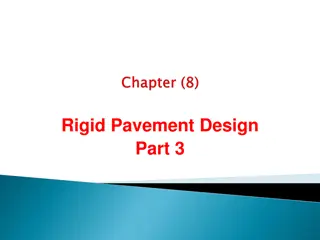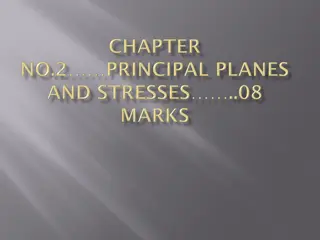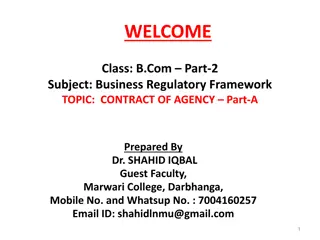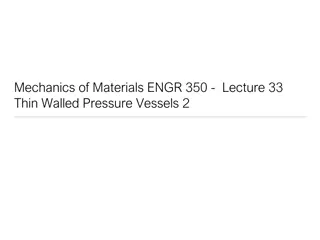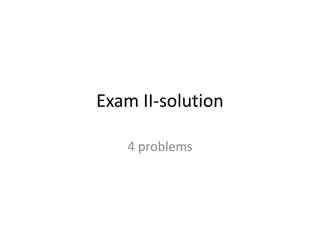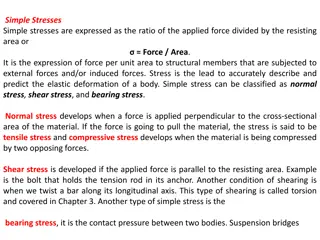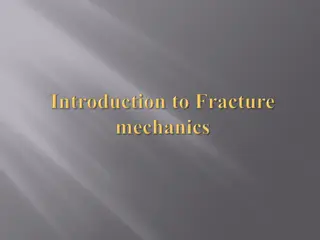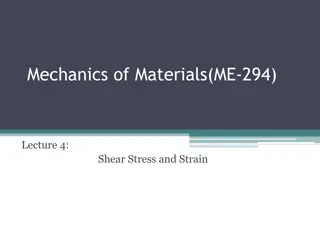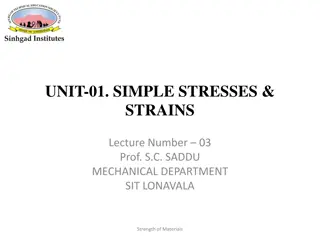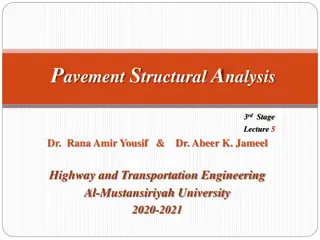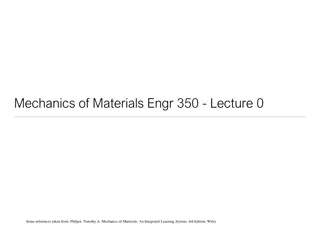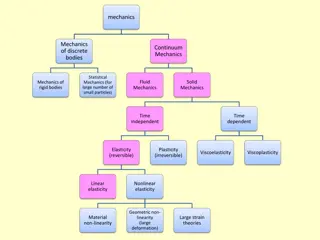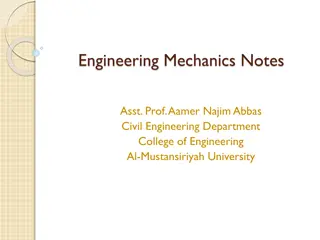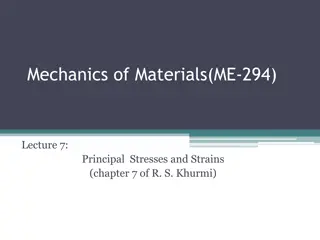Understanding Principal Stresses in Mechanics of Materials
In this lecture, we delve into the concept of principal stresses and how to determine the orientation of principal planes. We explore methods to find principal stress orientations and discuss the significance of principal stresses in materials. The content includes detailed equations, diagrams, and explanations to aid in understanding the key principles of principal stresses.
Download Presentation

Please find below an Image/Link to download the presentation.
The content on the website is provided AS IS for your information and personal use only. It may not be sold, licensed, or shared on other websites without obtaining consent from the author. Download presentation by click this link. If you encounter any issues during the download, it is possible that the publisher has removed the file from their server.
E N D
Presentation Transcript
Mechanics of Materials Engr 350 - Lecture 18 - Principal Stresses and Maximum Shear Stress Totally False Totally False
Review L17: Finding the orientation of principal planes What are principal planes? Orientations where normal stresses are maximum and/or minimum. Orientations where the shear stresses on the surface are zero. Option 1: How can we find the principal stress orientation? If you want to find the max and min of a function, take its derivative and set it equal to zero. ??=??+ ?? 2 2 ?? ?? + ???2? + ??????2? ??? ??= ?? ?? 2???2? + 2??????2? = 0 2 Some algebra gets this to: 2??? ?? ?? tan 2?? = 2
Review L17: Finding the orientation of principal planes Option 2: How can we find the principal stress orientation? Find the angle where shear stress is zero. ?? ?? 2 ???= ???2? + ??????2? = 0 Same algebra gets you to the same result: 2??? ?? ?? tan 2?? = 3
Review L17: Finding the orientation of principal planes What do we get from this equation? 2??? ?? ?? tan 2?? = ??is the orientation of the principal stress plane This equation is satisfied by two (really, four) values of ?? Each correct value of ??will be 90 apart from the other Direction of Rotation When tan 2?? is positive, ??is positive (rotate counter clockwise from x-axis) When tan 2?? is negative, ??is negative (rotate clockwise from x-axis) One value of ??will always be between -45 and +45 The other value of ??will be 90 away 4
Review L17: Magnitude of principal stresses What is a principal stress? It is the normal stress on one of the principal planes It is either the minimum or maximum normal stress in the material ??1is the maximum normal stress (most right on the number line) ??2is the minimum (most left on the number line) How to find the values Method 1 - Substitute each ?p directly into stress transformation equations Method 2 - Develop general equations for ?p1 and ?p2 Substitute 2?p values in eq. 12.11 derived earlier, and represent them as triangles (seen below) 5
Review L17: Magnitude of principal stresses Using SOA and CAH we can define the angle 2?p as: Substitute these in to Some algebra shows we get: If we substitute a value of 2? that is 180 away, we get: 6
Review L17: Magnitude of principal stresses We can combine these as one equation This equation gives you the magnitudes of both principal stresses if you input ?? ,?? ,and ??? If you don t need the orientation of principal stresses (only the magnitudes) you can get everything you need in this one equation 7
More Shear Stress and Principal Planes By definition, the shear stress on principal planes must be zero Inversely, if the shear stress on a plane is zero, then that plane must be a principal plane. Also, if we are considering plane stress (?z=?zx=?xz=0) then since the shear stress on the z-face is 0, then ?z must be a principal stress (we call this the 3rd principal stress) Even in 2D stress state, ?z = 0 can be an important piece of information 8
The Third Principal Stress We have determined principal stresses and planes for the case of plane stress These are the in-plane principal stresses We must not forget about the z-faces! ?z = 0, zx= 0, and zy= 0 A point in a material subject to plane stress has three principal stress ?p1, ?p2, and ?p3 One of these principal stresses is ?z = 0 (because no shear on the z-surface) Examples where: ?p1 is positive and ?p2 is negative ?p1, and?p2 have same sign 9
Orientation of the maximum in-plane shear stress (You already know that this is 45 from p) Prove it by differentiating Eq 12.6 wrt ? The solution of this equation is equation 12.14 in text 10
Comparing Eqn 12.11 and 12.14 Eq. 12.11 Eq. 12.14 One is the negative reciprocal of the other. The values of 2 pthat satisfy Eq. 12.11 are going to be 90 away from the values of 2 sthat satisfy Eq. 12.14 pand sare 45 apart Note: pis orientation of principle stress sis orientation of maximum shear stress 11
Magnitude of the max in-plane shear stresses Method 1 - Substitute ?s directly into equation 12.4 or 12.6 ?? ?? 2 ????= ???2?? + ??????2?? Get ?s by either adding 45 to ?p obtained from Eq. 12.11 solving Eq. 12.14 directly Method 2 Eq. 12.15 comes from combining eq. 12.6 and 12.14 obtain Method 2 is useful if you don t need to know the orientation of s 12
Other useful relationships 1. on planes where ? is maximum 2. The absolute maximum shear stress is given by 3. Remember that these are the largest and smallest numerically (not abs. value) 13
Example Stress States Find max, min, and abs max ?p1 ?p2, ?z 1. p1= 5, p2= 0, z= 0 ?p2 ?z ?p1 2. p1= 3, p2= -3, z= 0 ?p2 ?p1 ?z 3. p1= -2, p2= -5, z= 0 z= 0 really matters! 14
Presenting Planar Stress Transformation Results Method 1 - Two square stress elements Section 12.9 for details 15
Presenting Planar Stress Transformation Results Method 2 - wedge stress element Section 12.9 for details 16



